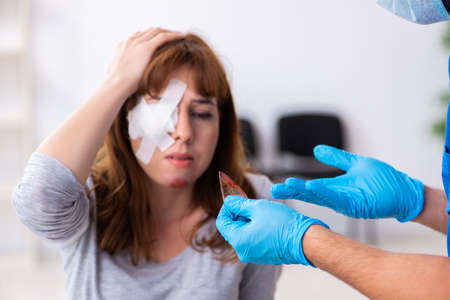Introduction: Understanding Chemical Peels in the UK
Chemical peels have become a buzzword across Britain’s skincare scene, with everyone from celebrities to everyday consumers considering them as part of their beauty regime. Once reserved for exclusive Harley Street clinics, these treatments are now offered everywhere from high street salons to boutique skin studios. The surge in popularity is fuelled by promises of brighter, smoother skin and the allure of a quick fix for common complexion woes. However, for every glowing review shared on social media, there seems to be an equally alarming anecdote warning of adverse reactions or long-term damage. This split in public perception has made chemical peels one of the most hotly debated topics in UK beauty circles. Are they truly the scientific breakthrough they claim to be, or do the scare stories hold more weight than we’d like to admit? As British consumers become increasingly savvy—and sceptical—about what goes onto their skin, understanding the real science behind chemical peels versus the myths is more crucial than ever.
2. The Science: How Chemical Peels Actually Work
Chemical peels have earned both admiration and suspicion in the UK’s skincare scene, but at their core, they are a precise blend of chemistry and biology. To demystify them, it’s essential to understand the mechanics behind how these treatments work and what sets professional peels apart from their high-street counterparts.
The Chemistry Behind Chemical Peels
At the heart of every chemical peel is an acid-based solution formulated to exfoliate the skin by breaking down the bonds between dead skin cells. This controlled chemical exfoliation encourages cell turnover and reveals fresher, more radiant skin beneath. The effectiveness and depth of the peel are dictated by several factors: the type of acid used, its concentration, pH level, and application time.
Primary Ingredients in UK Chemical Peels
| Ingredient | Type | Common Use in UK | Main Effects |
|---|---|---|---|
| Glycolic Acid | AHA (Alpha Hydroxy Acid) | Light to medium peels, often for brightening and texture smoothing | Exfoliates surface cells, boosts collagen production |
| Lactic Acid | AHA (Alpha Hydroxy Acid) | Gentle peels for sensitive or dry skin types | Hydrates while exfoliating; improves pigmentation |
| Salicylic Acid | BHA (Beta Hydroxy Acid) | Treating acne-prone or oily skin; popular in clinics and home-use kits | Penetrates pores, reduces inflammation, clears congestion |
| Trichloroacetic Acid (TCA) | Medium-depth acid | Used by trained professionals for moderate resurfacing | Treats pigmentation, fine lines, deeper textural issues |
| Mandelic Acid | AHA (from bitter almonds) | Suitable for darker skin tones; gentle exfoliation with minimal irritation | Evens tone, reduces mild acne, refines texture |
Physiological Effects on Skin
The action of a chemical peel triggers a cascade of physiological responses. Initially, the acid disrupts the stratum corneum (the outermost layer), loosening dead cells. This process stimulates cell renewal within the epidermis and can also induce mild injury in deeper layers (depending on strength), prompting natural repair processes. The result is smoother texture, improved clarity, reduction of fine lines, and evenness in pigmentation. Importantly, UK regulations ensure that professional-grade ingredients—especially medium to deep peels—are administered by qualified practitioners to minimise risks and tailor outcomes safely to individual skin types.
![]()
3. Efficacy and Benefits: Evidence-Based Outcomes
When it comes to chemical peels, separating hype from hard facts is essential. Over the past decade, a robust body of clinical research has emerged, clarifying what these treatments can—and cannot—achieve. According to studies published in leading UK dermatological journals and guidance from the British Association of Dermatologists (BAD), superficial and medium-depth chemical peels have demonstrable efficacy in treating common skin concerns such as hyperpigmentation, acne, melasma, and early signs of photoageing. Peer-reviewed trials consistently show that patients experience improvements in skin texture and tone after a series of professionally administered peels. For example, glycolic acid peels have been shown to reduce mild acne lesions and fade post-inflammatory pigmentation within 6-12 weeks, while trichloroacetic acid (TCA) peels are favoured for more pronounced sun damage or uneven pigmentation. Importantly, UK standards emphasise individualised treatment planning; NHS-endorsed protocols stress that outcomes depend on factors like peel depth, patient skin type (as classified by Fitzpatrick scale), and diligent aftercare. Expert consensus among UK dermatologists highlights that while chemical peels are not miracle cures or substitutes for medical therapies in severe dermatological conditions, they represent a scientifically validated adjunct for enhancing skin clarity and luminosity when performed by qualified practitioners adhering to UK health regulations.
4. The Scare Stories: Myths, Risks, and Urban Legends
Chemical peels are no strangers to sensational headlines in the UK press, often portrayed as either miracle fixes or potential nightmares. Let’s dissect the most prevalent anxieties and horror stories circulating about peels—many of which are fuelled by misinterpretation, outdated information, or urban legends rather than scientific evidence.
Media-Driven Myths vs Reality
The British media has a history of amplifying rare adverse reactions, sometimes overshadowing the everyday safety of clinically administered chemical peels. From tales of “melted faces” to dramatic photos of severe burns, these scare stories can easily put off those considering treatment. It’s vital to distinguish fact from fiction:
| Common Media Myth | Scientific Reality |
|---|---|
| Chemical peels cause permanent scarring for most people. | When performed by qualified professionals using suitable formulations, permanent scarring is extremely rare. |
| Peels are only for celebrities or risk-takers. | Peels are routinely used in NHS dermatology clinics for various conditions. |
| “One-size-fits-all” approach leads to unpredictable results. | Treatments are tailored to skin type, concerns, and desired outcomes, minimising risks. |
Risks: What Does the Science Say?
No cosmetic procedure is entirely without risk. However, the majority of chemical peel complications reported in UK media stem from unregulated practitioners or inappropriate products bought online. Genuine risks include temporary redness, peeling, hyperpigmentation (especially in darker skin tones), or infection—but these are largely preventable with proper aftercare and professional supervision. According to recent NHS guidance and British Association of Dermatologists’ recommendations, regulated clinics maintain high safety standards and carefully screen clients before proceeding.
Urban Legends in UK Pop Culture
Some urban legends—such as home-use acids causing irreversible damage after a single application—have become entrenched in British pop culture. Social media influencers occasionally fan the flames with dramatic “peel fails”, but these rarely represent typical experiences under clinical care. The narrative that peels “thin the skin forever” is also unfounded; in reality, controlled exfoliation stimulates regeneration and can improve overall skin health when performed correctly.
Takeaway: Informed Decisions Over Hearsay
In summary, while scare stories make for compelling tabloid fodder, most anxieties around chemical peels are rooted in misconceptions rather than empirical evidence. UK consumers should look beyond shock headlines and consult reputable clinics for accurate advice tailored to their individual needs and skin profiles.
5. Safety Standards and Best Practices in Britain
In the UK, chemical peels are governed by a robust framework of regulations and professional standards, which distinguish British practices from those in other countries. The Care Quality Commission (CQC) oversees clinics offering medical-grade peels, ensuring they adhere to strict safety protocols and ethical guidelines. Additionally, practitioners must possess appropriate qualifications—often including accreditation from bodies like the General Medical Council (GMC), Nursing and Midwifery Council (NMC), or the British Association of Dermatologists—demonstrating both clinical expertise and specific training in aesthetic procedures.
The Joint Council for Cosmetic Practitioners (JCCP) further supports public safety by maintaining a voluntary register of vetted professionals who meet high standards of competence and conduct. The UK also mandates thorough patient consultations prior to any peel, during which medical histories are reviewed, risks are explained, and suitability is assessed. This consultative approach is designed to prevent complications and ensure that treatments are tailored to individual needs.
Best practices in Britain emphasise not only practitioner credentials but also the environment where procedures are performed. Only clinics meeting stringent hygiene standards and equipped with emergency protocols should be considered. Furthermore, aftercare advice is integral; reputable UK providers supply clear written instructions on post-peel care to minimise adverse reactions and optimise results. Together, these uniquely British measures offer reassurance to clients, highlighting the nation’s commitment to responsible aesthetics amid rising demand for cosmetic treatments.
6. Future Trends: Where Are Chemical Peels Headed in the UK?
Chemical peels in the UK are on the brink of an exciting evolution, shaped by both technological innovations and a shift in public perception towards evidence-based skincare. As British consumers become increasingly savvy about ingredients and treatment protocols, demand is rising for customisable solutions that balance efficacy with safety. Recent trends show a move towards gentler, multi-acid blends that deliver results without significant downtime, catering to the fast-paced British lifestyle.
Emerging technologies, such as precision-targeted peels and formulations incorporating botanical extracts or probiotics, are gaining traction in clinics from London to Manchester. These next-generation peels promise enhanced skin barrier support, reduced irritation, and improved outcomes across diverse skin types—a nod to the UK’s multicultural population. Furthermore, digital consultation tools and AI-driven skin assessments are enabling practitioners to offer highly personalised treatment plans, elevating both trust and transparency in the professional skincare sector.
From a cultural standpoint, there is a marked departure from the old scare stories that painted chemical peels as drastic or risky procedures. Influenced by robust clinical data and regulatory oversight from bodies like the General Medical Council and Care Quality Commission, British clients now view chemical peels as sophisticated maintenance rather than a last-resort intervention. This evolving narrative is also reflected in mainstream media and influencer circles, where open discussions about science-backed treatments are replacing sensationalist myths.
Looking ahead, sustainability is set to be a key driver in product development. Brands are responding to consumer demand for eco-friendly packaging and ethically sourced ingredients—a trend particularly resonant with environmentally conscious UK audiences. Simultaneously, increased collaboration between dermatologists and aesthetic practitioners is raising industry standards, ensuring that innovation does not outpace patient safety or ethical practice.
In summary, the future of chemical peels in the UK lies at the intersection of cutting-edge science, personalised care, and culturally nuanced communication. As both technology and consumer awareness advance, British clients can expect more tailored, transparent, and trustworthy professional treatments—leaving scare stories firmly in the past.


